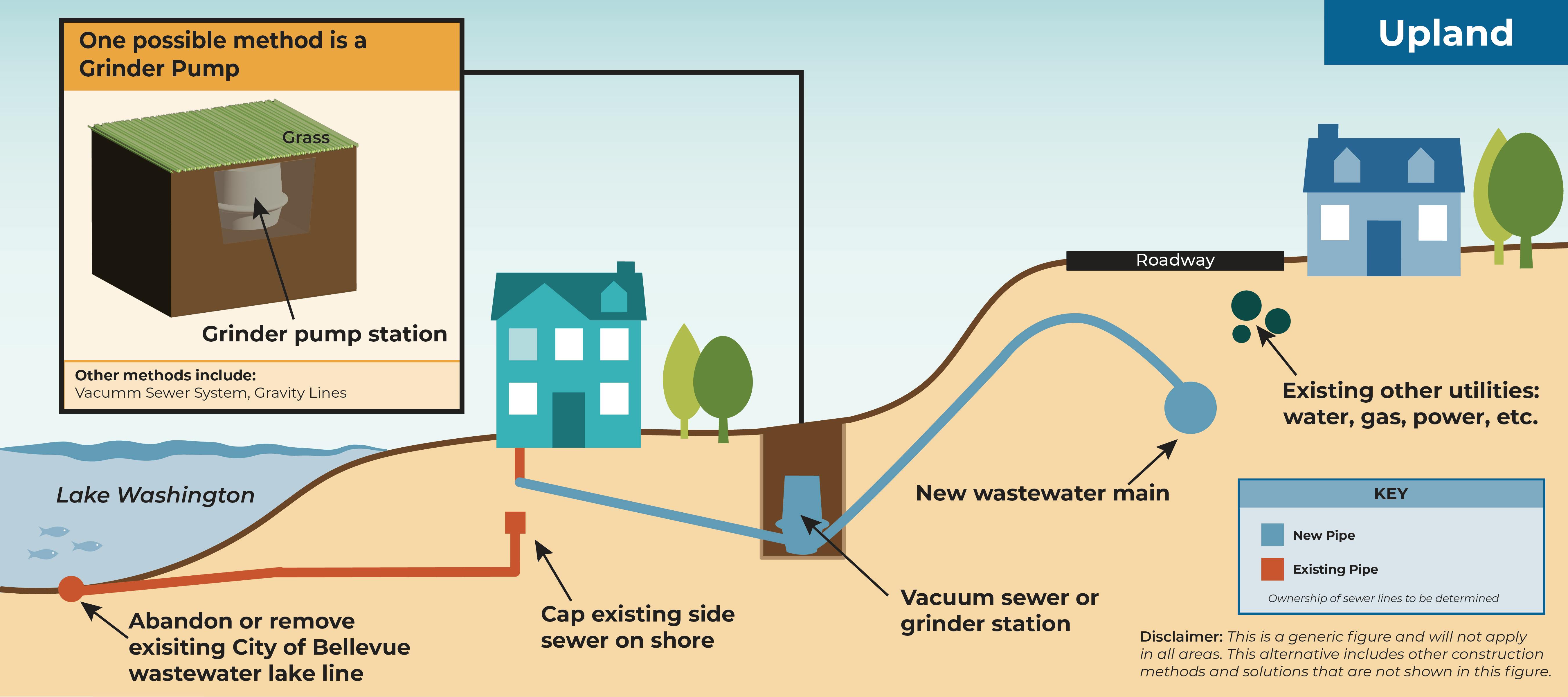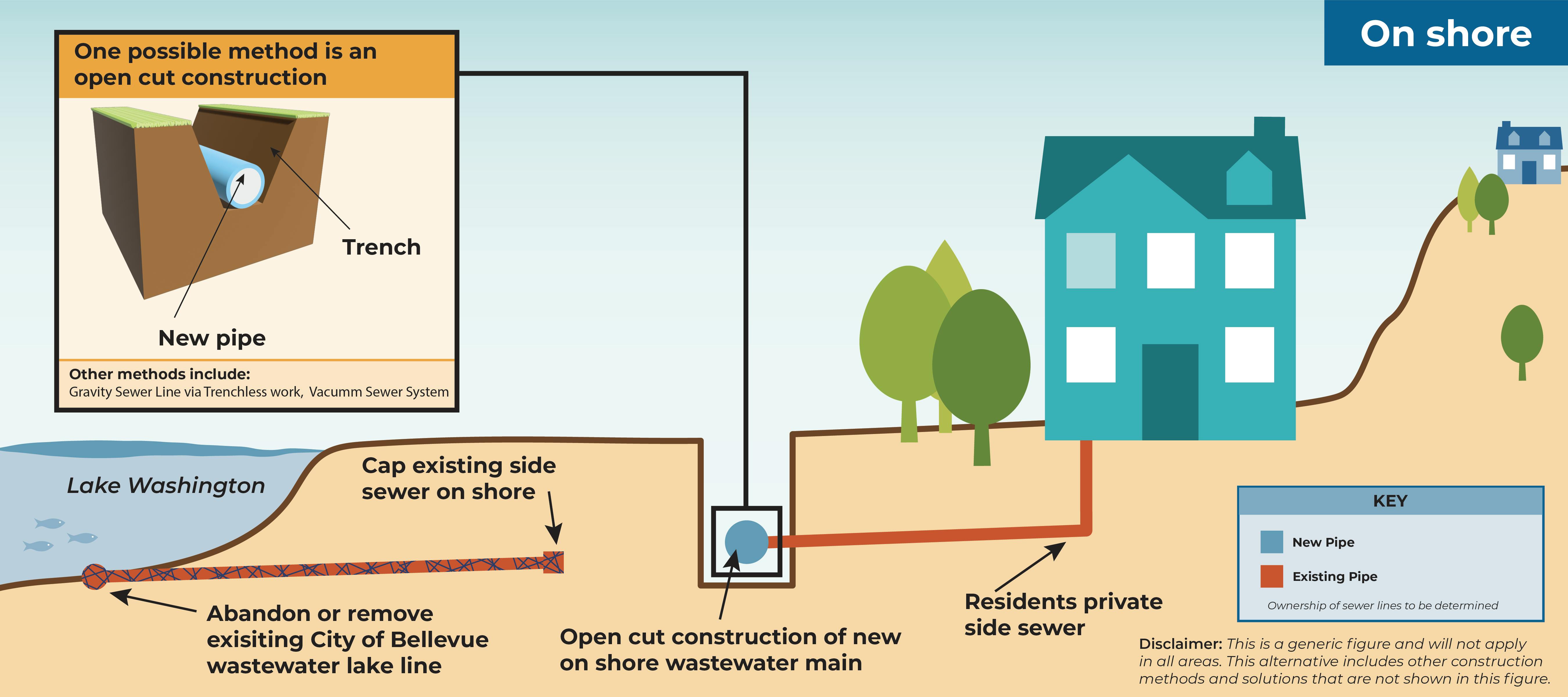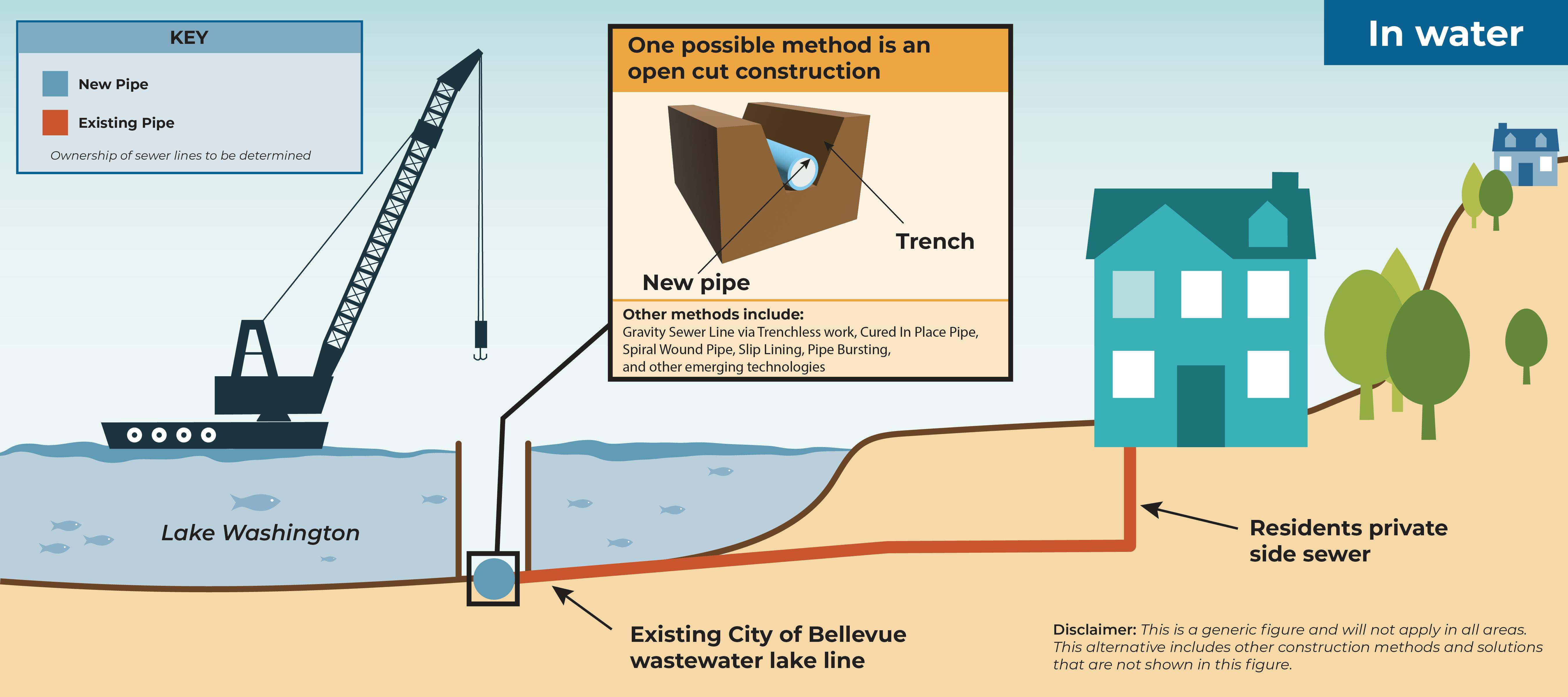Lake Washington Wastewater Lake Line Management Plan: Evaluation of Potential Alternatives
Consultation has concluded
Update:
The Lake Line Management Plan is final. We appreciate all of the community feedback and involvement we received. The plan and updated information can be found at www.BellevueWa.gov/lake-line-project.
Community input is critical as we continue to develop the Lake Washington Wastewater Lake Line Management Plan (Plan). The plan will help us provide reliable wastewater service and protect the Lake Washington ecosystem for generations to come. Since our team has completed the programmatic Draft Environmental Impact Statement (EIS), we are now conducting analysis of viable alternatives.
Your feedback is immensely important for the development of the plan. Share your comments with the team by submitting feedback on the question form at the bottom of the page, or by clicking here: Provide Feedback, 提供反饋信息 (Chinese), Suministre realimentación (Spanish), 피드백을 제공하다 (Korean), Обеспечить обратную связь (Russian), Cung cấp phản hồi (Vietnamese).
What is the Lake Line System? Lake line management will help Bellevue Utilities protect public health and the delicate Lake Washington ecosystem.
Lake line management will help Bellevue Utilities protect public health and the delicate Lake Washington ecosystem.
The City of Bellevue’s Lake Washington lake lines are an important part of the wastewater system located along the shoreline of Lake Washington. These wastewater pipes are either underwater or on land adjacent to the lake. Lake line pipes carry raw sewage from the shoreline properties to sewer pump and/or lift stations, which in turn, pump the sewage into an upland King County sewer system to eventually discharge into a King County Sewer Treatment Plant.
Most of the Lake Washington lake lines were constructed in the 1950s and '60s to prevent raw sewage from being directly discharged into the lake. Half a century later, this infrastructure now serves more than 1,000 community members in Bellevue and neighboring communities. However, the pipes in the lake line system are aging, and the shoreline and in-water location creates challenges for maintenance, repair, and replacement activities.
We need a Lake Line System Management Plan
In 2016, a preliminary condition Lake line wastewater pipes are either underwater or on land adjacent to Lake Washington assessment showed varying degrees of aging in the lake line pipes and interior pipe linings. Without advanced planning, the lake line system will begin to fail, potentially causing loss of service to residents and risk to our sensitive lake environment. Line failures could result in property damage to individual homes and widespread contamination of Lake Washington. Bellevue Utilities is developing a management plan for the repair, replacement, and maintenance of the system. The plan provides the framework to help ensure we can continue to provide safe and reliable wastewater service to the community and protect public health and the delicate Lake Washington ecosystem.
Lake line wastewater pipes are either underwater or on land adjacent to Lake Washington assessment showed varying degrees of aging in the lake line pipes and interior pipe linings. Without advanced planning, the lake line system will begin to fail, potentially causing loss of service to residents and risk to our sensitive lake environment. Line failures could result in property damage to individual homes and widespread contamination of Lake Washington. Bellevue Utilities is developing a management plan for the repair, replacement, and maintenance of the system. The plan provides the framework to help ensure we can continue to provide safe and reliable wastewater service to the community and protect public health and the delicate Lake Washington ecosystem.
Project Location
The Lake Washington lake line system includes approximately 14.6 miles of wastewater lines that are either underwater or on land adjacent to Lake Washington, as well as 15 pump stations and eight flush stations. The pipelines cross through the shorelines of Bellevue, Beaux Arts Village, Hunts Point, Medina, Yarrow Point, and King County. The lake line will be divided into planning areas for analysis and planning. Some areas of the lake line system may not require work; others may require repair, replacement, or continued maintenance.
either underwater or on land adjacent to Lake Washington, as well as 15 pump stations and eight flush stations. The pipelines cross through the shorelines of Bellevue, Beaux Arts Village, Hunts Point, Medina, Yarrow Point, and King County. The lake line will be divided into planning areas for analysis and planning. Some areas of the lake line system may not require work; others may require repair, replacement, or continued maintenance.
Prioritized areas
For planning purposes, the team has divided the Lake Washington lake line into six service areas:
- Hunts Point and Yarrow Point
- Evergreen Point
- Medina South
- Meydenbauer Bay
- Killarney
- Newport South
The team analyzed the likelihood that the lake line in each of the six areas might fail, and the consequence if that area failed. By combining those two factors, the team developed recommendations for when each area may need repair or replacement.
The Meydenbauer Bay service area was ranked as the highest priority with action needed in the next ten years. Following Meydenbauer Bay was:
2. Newport South
3. Hunts Point and Yarrow Point
4. Killarney
5. Evergreen Point
Each of those service areas are likely to need comprehensive system improvements in the next 10 to 20 years. Medina South was the lowest priority, with system improvements needed in more than 20 years.
In each area, there are some early data collection, maintenance and/or operational or repair activities that will be needed in the near term.
Potential Solutions
The Lake Line System presents multiple technical, environmental, operational, and financial challenges because of its location in and adjacent to the lake. In the future, the project work could have impacts on the environment, as well as property owners and the public. The management plan will help us identify potential solutions and their impacts, laying groundwork for future design and construction projects. Potential solutions could take place in the lake, on land and on individual properties. It is important to note that different areas of the system will have different recommended alternatives - there will not be one alternative recommended for the entire Lake Washington Lake line system. A “no action” alternative is also an option, and could involve emergency repairs and maintenance.
Alternative 1 - In water
- Refers to pipes below the ordinary high water of Lake Washington. Lake Washington’s water level fluctuates. Ordinary high water is a measure of the typical high point of the lake.
- Potential solutions could include monitoring the condition of existing lines, repairing existing lines or replacement of lines.
- Methods could include installing gravity sewer line via open cut trenchless (below-ground drilling) construction or, trenchless rehabilitation (techniques could include cured-in-place pipe spiral wound pipe, slip lining, pipe bursting, emerging technologies)
 One potential method to replace lake lines in the lake water could be done by open-cut construction.
One potential method to replace lake lines in the lake water could be done by open-cut construction.Alternative 2 - On shore
- Refers to pipes that are generally located near homes and the shoreline, above the ordinary high-water line of Lake Washington.
- Potential solutions could include monitoring the condition of existing lines, repairing existing lines or replacement of lines.
- Methods could include installing a new gravity sewer line via open-cut trenchless construction or vacuum sewer system.
 One potential method to replace lake lines on shore could be by open-cut construction.
One potential method to replace lake lines on shore could be by open-cut construction.Alternative 3 - Upland
- Refers to portions of the conveyance system that are located upland of homes and within the general vicinity of the public right-of-way.
- Potential solutions could include monitoring the condition of existing lines, repairing existing lines or replacement of lines.
- Methods could include installing a new gravity sewer line via open-cut trenchless construction or installing a new grinder pump or vacuum sewer
 One potential method to replace lake lines is by installing a new grinder pump up to a new wastewater main upland.
One potential method to replace lake lines is by installing a new grinder pump up to a new wastewater main upland.Alternative evaluation factors
The proposed alternatives are now being evaluated based on the following factors:
Permitting – Evaluate the effort required to prepare and obtain the necessary permits from local, state, and federal agencies.
Environmental Impact – Evaluate the impacts to regulated environmental resources (geologic hazard areas, or lake, wetland, stream or associated buffers).
Right-of-Way and Easement – Evaluate the extent to which land use rights would need to be acquired or modified to implement the alternative.
Performance, Operation, and Maintenance – Evaluate how the location of the lake line system impacts the ease and feasibility of long-term maintenance to be performed.
Constructability – Evaluate the difficulty and risk associated with constructing the alternative.
Cost – Evaluate the relative total cost of the alternative, including design, construction, mitigation, permitting, & life cycle.
Local Community and Stakeholders - Evaluate the potential impacts to residents, community groups and partners. Anticipate any potential challenges or concerns.
 The team evaluated a range of alternatives for each service area, considering seven evaluation factors for each alternative.
The team evaluated a range of alternatives for each service area, considering seven evaluation factors for each alternative.Help shape the future of clean water
Your comments will be used to inform the evaluation of each alternative. Community feedback will be used in the analysis of each alternative to help determine the best options for the management plan.
Timeline
We anticipate completion of the management in early 2024. We need your input now to help narrow down the prioritization and the evaluation criteria described above.






